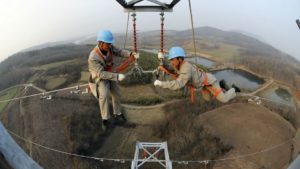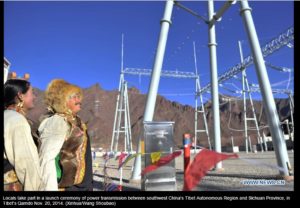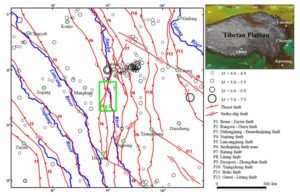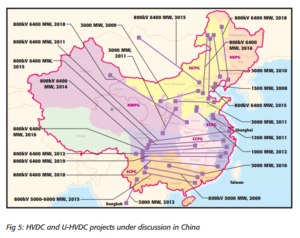BIG RESERVOIRS AND BIG DAMS
#4 in a series of 8 blogs on China’s latest plans for Tibetan rivers
The big new reservoirs for diverting Tibetan waters northward to the exhausted Yellow River are far from the only Chinese interventions on Tibetan rivers scheduled for the 13th Five-Year Plan and beyond. While water is diverted north, electricity generated in Tibet by several cascades of hydropower dams is to be despatched east, right across lowland China to the industrial hubs of coastal China such as Shanghai and Guangzhou. This means exporting electricity as far as 2000 kms from where, in Tibet, it is generated.
The construction of the big reservoirs and the big dams are intertwined, firstly because the locations best suited to dams and reservoirs are usually packed into stretches of river with steep valleys, and secondly because the water diversion reservoirs in some cases need to be surrounded by hydro dams to generate enough electricity to pump water uphill from Yangtze tributaries and into Yellow River tributaries. Third, the hydro dams are to be supplemented, higher up in the headwaters of Tibetan rivers, by new reservoirs big enough to hold back the summer monsoon downpours, for later seasonal use, to guarantee year-round hydropower for Shanghai and Guangzhou. Big dams, in China’s plans, come in cascades, topped by big reservoirs.
However, just as the south-to-north S2NWestern Route of water diversion projects has created its own world of plans, rationales, arguments for and against, budgets and workforces; so too has the West-to-East plan for “transferring Tibet’s electricity out”, a literal translation of the official title of the program.[1] The connotation inherent in this way of framing the whole idea is that the electricity is already implicitly there, already existent. All that is needed is to actually build the hydro dams and the ultra high voltage power lines, and the electricity will be liberated from its entrapment in mountain rivers, and will flow freely to the east, instead of being wasted in wild and fast rivers heading south, often to the south of China altogether. This naturalises extraction, and gives it a suggestion of progress, modernity and even inevitability. S2N Western Route for water diversion, is now joined by W2E UHV electricity transmission.
A similar phrase is used officially to define what in other countries is called the farmgate offtake rate, or turnoff rate, meaning the number of animals, or other farm products entering the market, available for purchase. In China this is, literally, “the come-out rate”, 脱出率, tuōchū lǜ, which can also be translated as “escape rate.”
The different concepts inherent in the different categories are significant. To turn off animals, to bring them to the farm gate, gives agency to the livestock producer. It is his/her decision to bring animals to the space in which they enter the commodity chain. In a modern ranching livestock economy, livestock and livestock products such as milk, meat or hides are considered to be marketable commodities at all points of the production process, while growing onfarm, and when available to buyers. In China, especially in Tibet, livestock herded by mobile Tibetan pastoralists are not only unavailable, they are invisible, barely subject to official scrutiny. Only when they do “come out” into the marketplace do they suddenly exist, as measurable commodities to be assigned monetary value. Until they “come out” they are known to exist, but not measurably so, and as their owners do not see their herd as meat-in-the-making, but rather as valuable in their own right, on the hoof, they cannot be considered commodities being readied for the market, unless and until the herd owner does, unpredictably, put them on the market. The concept of “come out rate”, the term used repeatedly in official statistics, awards all agency to the traders, slaughterers and meat processors to whom the animals “come out”; while the producer remains unnamed.
Implicit in the W2E concept of “transferring Tibet’s electricity out” is the embedded official rhetoric of Tibet as the (ungrateful) beneficiary of massive support and assistance from China, with little to show for it, little by way of pay-off. This is the discourse of the gift, not a gift freely given, but an official gift from a benevolent central authority which has every reason to expect reciprocity, a return payment of tribute that acknowledges official generosity. Tibetans have failed, it seems, to pay tribute or to express gratitude. The time has come to take what China needs. “Tibet’s electricity”, like Tibet’s natural resource endowment and mineral deposit patrimony are all assumed to be not only available for extraction, but to be, by virtue of being found and categorised, to be ready to come out into Chinese hands. From mineral deposit to mine is but a short step, in this popular imaginary. As soon as a mineral deposit has been identified, it becomes an asset. The entire grassland of Tibet can become an asset class, transformed by order from above, from livestock production landscape to carbon capture and watershed protection zone. The monetary loss when animals no longer “come out” to market for slaughter is considered minor, compared to the gain, for China’s soft power, of being able to point on maps to huge areas, mostly in Tibet, set aside for carbon capture and watershed protection.
On the high plateau China is rapidly giving up on animals “coming out”, as a hope that failed, in favour of a completely different mode of meat production by intensive feedlot ranching agribusinesses on urban edges. But China does not retreat at all from W2E “transferring Tibet’s electricity out” to distant cities of coastal China via power cables slung right across the country from west to east. Implicit in the concept is that the electricity, like the minerals and the meat, is already there, all that is needed is required infrastructure, of dams, turbines and power pylons, to transfer “Tibet’s electricity” to where it is in demand. Then the gift of development will at last bear fruit. This is an issue which the human geographer Emily Yeh has explored in much depth.[2]
As with intensifying the “come-out rate” and also with diverting Tibetan rivers northwards, the prospect of a dividend paid by Tibetan rivers in electricity production has a long history. This is a dividend for lowland China long anticipated, long planned and included in successive Five-Year Plans. The plan is for the ultra high voltage (UHV) power lines to begin, in the valleys of Tibetan rivers, at an altitude of 3650 metres.[3] Power pylons and cables must march up and over mountain ranges, in as straight a line as possible, to minimise construction costs and loss of electricity. Where necessary, they will march straight over parks and protected areas, even over the UNESCO World Heritage Three Parallel Rivers (see a later blog in this series for more). The rivers and mountains of eastern Tibet are oriented NNW to SSE, while the power lines are west to east, so the extraction of electricity from Tibetan rivers necessitates many crossings of high mountain ranges, against the grain of the land.
Mountains make their own weather. Mountains can generate storms out of clear skies. Tibet, the land surrounded by mountains, is so susceptible to thunder and lightning that China made a big book atlas of Tibetan clouds, because they are so unlike China’s clouds.
IS MASSIVE ELECTRIFICATION ACTUALLY GOING TO HAPPEN?
Yet the planning proceeded, as if all of nature can be conquered. A 2013 summary of this W2E mega project, by the Woodrow Wilson Center, states: “The West-East Electricity Transfer Project. Initiated during the 10th five-year plan (2000 to 2005), the project is designed to bring investment and development to China’s lagging west while satisfying the growing electricity needs of the country’s eastern provinces.
“The project’s first phase has been and is continuing to expand the western provinces’ electricity-generating capacity, primarily through the construction of new coal bases and hydroelectric dams. The second ongoing component is the construction of three electricity-transmission corridors that connect newly built generation capacity in the north, central, and south to the coast.
“Each of the corridors is expected to exceed 40 gigawatts in capacity by 2020 – a combined capacity equivalent to 60 Hoover Dams. The seven recipient provinces – Beijing, Tianjin, Hebei, Shanghai, Zhejiang, Jiangsu, and Guangdong – together consume nearly 40 percent of China’s total electricity.
“Yunnan’s Nuozhadu Dam on the Mekong River was constructed as a part of this project, and has been touted as part of the backbone of the southern corridor, sending two-thirds of its output to Guangdong – the leading province in export manufacturing.
“The controversial Three Gorges Dam is an integral component in the central corridor, sending 35 percent of its electricity to the Yangtze River Delta – China’s second largest manufacturing region, behind Guangdong. The southern corridor also receives energy from the Three Gorges Dam, albeit only about 16 percent of the dam’s output.
“Also along the central corridor, the longest, single ultra-high voltage direct current line in the world connects the Xiangjiaba dam on the Yangtze River (between Yunnan and Sichuan provinces) to Shanghai. It is 1,287 miles long and has a capacity of 6.4 gigawatts.”[4]
China’s capacity to intercept Tibetan rivers, convert their rushing waters into electricity and transmit electricity on ultra high voltage power lines right across China, all rely on technologies China proudly proclaims to lead the world in. The ultra high voltage direct current (UHVDC) power lines stretching across the forested hills of Yunnan are pioneering Chinese technology, though specialist foreign assistance is still needed. China initially relied on Siemens for the first ultra high voltage lines across China from west to east, but now does the build itself.
It seemed China’s mastery of this new technology by the earliest years of this century had solved several nagging problems. UHVDC overcomes the old problem afflicting long distance transmission, that electricity leaks away, so much so that what arrives is much less than what was generated. All the glitches seemed to have been overcome, until the height of the annual monsoon plum rains, on 19 August 2010, when a lightning strike in the Yunnan hills caused such great electromagnetic interference that within minutes the entire system crashed. The same thing happened in the next monsoon season too: “On June 5th, 2011, a similar incident happened after a lightning strike to one DC pole, resulting in a bipolar block with power loss of 3500 MW and large electrical oscillations to the AC networks connected to both sending and receiving terminals.”[5]
The engineers thought they had built into their designs sufficient insulation to handle lightning strikes, but this was literally overpowering. The problem was unexpected, and meant a basic rethink, especially since the full rollout of the west-to-east electricity transfer includes hydropower stations and UHVDC power lines starting at high altitude in Tibet. Lightning strikes in Tibet are frequent, at an altitude deep into the troposphere, with mountain ranges roiling and forcing clouds to ascend sharply. Thunderstorms are common, and seem to come out of nowhere, with little warning, mostly in summer, but occurring unpredictably in any season.
Just when the technology seemed set, a rethink was needed, if Tibet was to be included. In thin air, how far apart do power lines have to be, if lightning flashover, from one line to another, is to be avoided? Was it back to the drawing board? Had the nature of Tibet yet again confounded Chinese expectations?
This is a massive project, requiring of the state and its state-owned corporations, massive outlays of capital expenditure (capex) to build all the dams, tunnels, turbines, pylons and ultra high voltage cabling across China from Tibet in the west to the cities of the east. The construction phase is measured in decades, with an even longer planning phase beforehand. Equally massive will be the profits, when wealthy urban consumers and industries pay for the electricity arriving from Tibet. Will Tibetans become power merchants? Will Tibetans become electricity traders, selling to the highest bidder, as in many market economies? What will Tibetans be paid for the extraction of their water and energy of the wild mountain rivers tamed by dam cascades? Will the Khampa and Amdowa Tibetans of eastern Tibet be paid anything at all, either as compensatory “Payment for Environmental Services”, or as royalties for the loss of natural resource endowments? Or are the waters and energy inhering in those rushing waters treated as free public goods, free to whoever can capture them?
Although this project has been planned for decades, the planners are silent on these questions. By default, the assumption is that the rivers are a state-owned common pool resource, available to whoever can harness them to serve immediate human interests. Inevitably, the propaganda spin is that both S2N water diversion and W2E UHV electricity in turn deliver the gift of development to under-developed Tibet, for which the Tibetans should feel gratitude. And, at national and international levels, China is applauded for recommitting to renewable energy, including hydro, as an alternative to polluting coal.
In reality, it is not so simple. In the short-term, China has been squandering much of the hydro electricity generated by the dams built recently, dissipating the electricity created by turbines spun by water, because the electricity grid had no interest in accepting connections, or in integrating hydro fully into the mix of energy sources. This wasteful refusal to connect the dots was revealed in early 2016, after having intensified over many months.
IS WATER THE RESOURCE CURSE OF TIBET?
For most of this young century it seemed that, if the resource curse afflicted Tibet it would be due to extraction of minerals, especially as China’s manufacturing hubs move deep inland, away from coastal China’s high wages and environmental regulatory enforcement, to cities at the foot 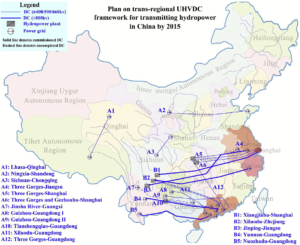 of the Tibetan Plateau such as Chongqing and Chengdu. Tibet’s endowment of copper, gold, silver, molybdenum, lead, zinc, lithium, potassium and common salt, as well as oil and gas fields, all portended intensive resource extraction, with very little employment or vocational training offered to Tibetans. Much was written about this impending resource curse, which turned out to be premature. As commodity prices started to fall sharply, starting in 2012, mining companies worldwide started to scale back their investments in opening up new mines and the infrastructure of processing and transporting minerals to markets. China’s state-owned energy and mining corporations, for many years at the forefront of China’s learning to do business worldwide, including global sourcing of raw materials, slowed their investment in the many big copper deposits in Tibet, which all produce gold, silver and other metals along with the copper. These may yet become a resource curse, if they do again scale up, and if they further displace and disempower local Tibetan communities, while failing to train or employ them.
of the Tibetan Plateau such as Chongqing and Chengdu. Tibet’s endowment of copper, gold, silver, molybdenum, lead, zinc, lithium, potassium and common salt, as well as oil and gas fields, all portended intensive resource extraction, with very little employment or vocational training offered to Tibetans. Much was written about this impending resource curse, which turned out to be premature. As commodity prices started to fall sharply, starting in 2012, mining companies worldwide started to scale back their investments in opening up new mines and the infrastructure of processing and transporting minerals to markets. China’s state-owned energy and mining corporations, for many years at the forefront of China’s learning to do business worldwide, including global sourcing of raw materials, slowed their investment in the many big copper deposits in Tibet, which all produce gold, silver and other metals along with the copper. These may yet become a resource curse, if they do again scale up, and if they further displace and disempower local Tibetan communities, while failing to train or employ them.
Meanwhile, S2N Western Route water diversion and W2E UHV electricity transmission now loom as more immediate prices to be paid by Tibetan communities, especially in the deeply unhappy prefectures of Kandze and Ngawa in Sichuan. The resource curse is imminent, but its focus has shifted. When minerals are dug out of the ground, the concept that they belong, at least in part, to local communities, is well-established, and embedded in the concept of “resource rental” taxes payable by miners to communities (or governments) in compensation for the loss of resources.
No such concept applies to water or to hydropower, both of which are classified as “renewable”, and therefore self-regenerating. No royalties or resource rental payments apply. In the minds of central planners, both have been going to waste, and it is a sign of an advanced civilisation that at last the waste is to be stopped, and these resources put to human use. How could wasteful Tibetans suddenly expect to be paid?
The entire W2E UHV electricity transmission project is driven by the 2004 electricity shortage, in the coastal cities which were then the locus of the world’s factory. At a time when the world’s factory was not only in China, but concentrated in a dozen coastal cities, the only constraint on China making anything and everything the world would buy was the power shortage. No matter how much China (with the World Bank) tried to build coal-fired power stations in those cities, expand the rail network to get coal trains from the north to the cities of eastern and southern China, and build even more power stations in the north, it seemed impossible to keep up with demand. A dramatic new alternative was needed. The coastal cities, instead of always looking north for energy, could also look west, to the rivers of Tibet. The moment for W2E UHV had come.
In reality, it requires three successive Five-Year Plans to actually build the infrastructure needed, if not longer; and over the 15 years from 2006 to the planned W2E UHV completion date of 2020 much has changed. China’s imports of raw, unprocessed commodities requiring electricity for processing, has dropped. Demand for China’s manufactured exports has dropped, month after month. Manufacturing hubs are moving inland. China is trying to create a consumer-driven economy, no longer reliant on producer-driven heavy industry backed by state finance. Much energy-intensive industry such as aluminium smelting, has shifted to Xinjiang, where coal is plentiful and local populations are in no position to demand environmental regulations be enforced.
Despite these many deep shifts, W2E UHV continues to be built. It has become a question of national pride, and becoming an exemplary showcase for China’s power grid builders, who seek contracts worldwide building power networks.
As a package of alluring hydro potential, China’s West offered many opportunities, with Tibet the most remote and thus the last to be interconnected. Below Tibet there are also dams and hydropower stations to be built, and they were built first. The logic could be explained simply: “Nearly two-thirds of hydro resources are distributed in the south west and west of China, including Sichuan, Yunnan and Tibet provinces. Two-thirds of the coal reserves are distributed in the north west and north of China. On the other hand, two-thirds of electricity loads were in the east of China where there is a lack of electricity energy sources. The distances between the areas of energy resources and energy demand are up to 2000km, which means that it is easier to transport electricity than the raw energy resource.”[6]
This is the logic, a decade later, still driving W2E UHV. A major reason why intensive exploitation of hydro potential is still at the top of the energy agenda is the failure of China’s coastal cities to embrace gas as an energy source that is plentifully available within China, by pipeline from just beyond China in Central Asia, and, for those coastal cities, also readily available by ship from afar. The plan was for a big transition to gas, because many gas fields were discovered, so many in fact that gas prices have remained low, due to oversupply. A further reason was to reduce air pollution, as gas burned to generate electricity does produce greenhouse gases, but not as badly as coal. But not all plans come to fruition, especially when it is up to local governments and corporations to invest in switching technologies, from coal to gas.
China is also investing in the biggest expansion of nuclear power ever, also in the hope of exporting its nuclear power stations worldwide. And China’s investment in solar power and wind power, again driven by hopes of dominating export markets worldwide, has been massive. Yet none of these have deflected the 15 year plan to have W2E UHV electricity operational by 2020. Despite the talk of a “green China”, with greatly improved energy efficiency, one constant has been the assumption that electricity demand will continue to rise and rise.
Because of the enormous distance between Tibetan generators and Shanghai consumers, China opted for not only ultra high voltage, but also DC direct current, which requires fewer lines. That might seem an advantage, but from the viewpoint of the security state, ever vigilant against the danger of splittists and terrorists, reliance on a few UHV lines is also a risk: “Concentrating the power transfer on a smaller number of overhead lines obviously increases the operational risks posed by these lines being taken out of operation in an unplanned fashion, either due to random reasons such as weather related incidents or technical failures, or due to malicious attacks and sabotage.”[7]
China’s embrace of not only ultra high voltage but especially UHV direct current (DC) requires a bipolar set-up, exaggerating the danger of the whole system crashing if disrupted by lightning. UHV DC also requires the use of many thyristors of a very uniform quality, achievable only by neutron bombardment done within a nuclear reactor: “Neutron bombardment leads to a homogenous distribution of impurities with very small distortions of the crystal, which is ideal as semiconductor material for high-power thyristors used in HVDC converter stations. The doping of semiconductors with neutrons is carried out in research reactors or in reactors of nuclear power plants.”[8] Mastering this technology, on the huge scale required for transmission of electricity as much as 2500 kms across China, from Tibet to Guangzhou, leaves some experts sceptical about whether China can meet its target of 2020.[9]
But China officially is committed to going ahead, and becoming a leading global builder of UHV DC in many countries. The transmission of electricity right across China, from Tibet to Shanghai will be the exemplary model, the proof of China’s capabilities, with State Grid Corporation feted as China’s national champion. Exporting electricity from Tibet will enable China to export its grid builders globally. The Tibetan dividend is more than water and electricity. It “unites China”, builds a unitary state whose citizens are of only one nationality, the Chinese nationality (Zhonghua minzu); all other identities being erased. Electricity from Tibet becomes China’s calling card to do something similar worldwide.
[1] http://en.kangbatv.com/news/201604/t20160429_2768541.shtml#sthash.XnY5bySt.dpuf
[2] Emily T. Yeh, Taming Tibet: Landscape Transformation and the Gift of Chinese Development, Cornell, 2013
[3]Z. Y. Sun, W. M. Liao, Z. Y. Su and X. J. Zhang, “Test Study on the Altitude Correction Factors of Air Gaps of ± 800kV UHVDC Projects”, Power System Technology, Vol. 32, No. 22, pp. 13-16, 2008.
- L. Yang, F. Z. Zhang, F. Zhao, L. M. Wang and Z.C. Guan, “DC Flashover Performance of ±800kV Composite Post Insulator in High Altitude Area”, High Voltage Engineering, Vol. 35, No. 4, 749-753, 2009.
Yongxia Han, Li Tang, Licheng Li, Qiuping He, Yanpeng Hao and Senjing Yao, Influence of Lightning Flashover Criterion on the Calculated Lightning withstand Level of ±800 kV UHVDC Transmission Lines at High Altitude; IEEE Transactions on Dielectrics and Electrical Insulation Vol. 22, No. 1; February 2015
[4] https://www.wilsoncenter.org/article/map-chinas-west-east-electricity-transfer-project#sthash.IRiTjSBS.dpuf
[5] Xiao Zhang, Zhanqing Yu, Jinliang He, et al., Mechanism of ±800 kV HVDC converter abnormal block fault causedby lightning transient, Electric Power Systems Research 113 (2014) 157–164
[6] X-P Zhang, C Rehtanz and Y Song, A Grid for Tomorrow, IET Power Engineer | October/November 2006
[7] A Grid for Tomorrow
[8] Christof Humpert, Long distance transmission systems for the future electricity supply: Analysis of possibilities and restrictions, Energy 48 (2012) 278-283
[9] Humpert, Long distance transmission systems
